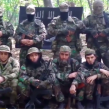
Is It Too Early to Write off the Caucasus Emirate?
Publication: Eurasia Daily Monitor Volume: 13 Issue: 9
By:

With the start of a new year, the situation involving the militarized Islamic jamaat of Kabarda, Balkaria and Karachai (KBK), which operates in two North Caucasian republics, Kabardino-Balkaria and Karachaevo-Cherkessia, remains unclear. When Caucasus Emirate (CE) militants started to switch allegiance to the Islamic State (IS) en masse in 2015, the KBK jamaat could not decide which camp it belonged to. The IS proclaimed the establishment of a province (velayat) on the territories of Chechnya, Ingushetia, Dagestan and Kabardino-Balkaria. Abu Muhammad al-Adnani, spokesperson for self-proclaimed caliph Abu Bakr al-Baghdadi, made the announcement (Gazeta.ru, July 24, 2015).
Al-Baghdadi appointed Abu Muhammad Kadarsky (Rustam Asilderov) as valiy (ruler) of the velayat (Infochechen.com, July 23, 2015). Asilderov had previously headed the Dagestani part of the CE. The prospects of the CE looked dim, since many observers thought all of its members would eventually join the IS. That, however, did not happen—or, more precisely, attempts to revive the CE continue.
The KBK’s amir, Salim (Zalim Shebzukhov), who was affiliated with the Caucasus Emirate and officially declared dead, unexpectedly reemerged in an audio recording posted on YouTube at the end of December 2015 (YouTube, December 28, 2015). In the seven-minute address to his supporters, Shebzukhov asked them to excuse him for not clarifying the situation with the split of the KBK jamaat into supporters of the CE and the IS. Shebzukhov claimed that many of those who pledged allegiance to the IS were actually prepared to join him, but were killed in special operations. He reproached those who left the CE in favor of the IS and promised that CE would be restored and that those who left it would regret their decision.
It was a strange address by a rebel amir who was reportedly killed in a special operation in Nalchik back in April 2015 (Kavkazsky Uzel, April 16, 2015). Even though the authorities reported Shebzukhov’s death multiple times, his silence since April 2015 still appears to be quite strange, especially given the ongoing dispute between the CE and IS. Some of Shebzukhov’s former associates who know him personally and joined the IS immediately responded to his call, saying that he should also join the IS rather than returning to the CE (Justpaste.it, January 7).
The first indication that Shebzukhov was alive came in August 2015, when an IS member named Shakh Shakhov called on him via the Internet to recognize the IS and join the organization (YouTube, August 31, 2015). Since IS members in Kabardino-Balkaria suffered significant losses in November 2015, including the killing of their leader, Robert Zangishiev (Rosbalt, November 22, 2015), Shebzukhov’s position has strengthened.
Another surprising development in the KBK jamaat was tied to Karachaevo-Cherkessia. The KBK formally includes the Karachaevo-Cherkessian jamaat, but the latter essentially disappeared after powerful blows by the Russian security forces in 2007–2009. A joint jamaat of Kabardino-Balkaria and Karachaevo-Cherkessia, the KBK appeared in response to the de-facto elimination of the Karachaevo-Cherkessian jamaat. Despite many years of tranquility, on December 24, 2015, the authorities, in a surprise move, introduced a counterterrorist operation regime in the Adyge-Khabl and Prikubansky districts of Karachaevo-Cherkessia and the northern part of the capital, Cherkessk (Rosbalt, December 24, 2015). Government forces killed three suspected militants, reportedly while trying to arrest them. This is a signal that the Karachaevo-Cherkessian jamaat still exists and they may have created their own cell within the structure of the KBK jamaat. If the slain militants were affiliated with Shebzukhov, the latter will take credit for the revival of the Karachaevo-Cherkessian militancy and members of the IS will have to take him into consideration.
At this point, it is hard to believe the CE will revive, because six months have passed since the last leader of the organization, Amir Abu Usman Gimrinsky (Magomed Suleimanov), was killed (Lifenews.ru, August 11, 2015). However, external actors are also interested in keeping the CE alive, especially those who are fighting under the CE’s banner in Syria. The amir of the “Caucasus Emirate” group in Syria, Salaudin Shishani (Paizulla Margoshvili), is one of those commanders who have refused to pledge allegiance to anyone other than the CE. In October 2015, Russian media extensively reported on the death of the leader of the “Caucasus Emirate” in Syria (Lenta.ru, October 22, 2015), but for some reason no Russian media outlet mentioned the name of the group’s leader. Amir Salahuddin Shishani, along with his deputy, Abdul Karim Krymsky, recently left Jaish al-Muhajireen wal-Ansar and created their own group. Salahudin Shishani created his own battalion, which he calls “the Caucasus Emirate in Syria,” and his militants wear a uniform with the symbols of the CE (sword and shahada). The actions of Amir Salahuddin and some figures in Istanbul, such as Akhmad Umarov, the brother of former CE leader Doku Umarov, do not allow the CE to disappear completely.
The increased activities of the KBK militants at the end of 2015, therefore, seem to signify the revival of the jamaat, which may potentially destabilize the situation in that part of the North Caucasus. It appears that the CE cannot yet be discounted and will likely reappear in the news.




